8 Most Common Types of Butterflies in Texas (With Pictures)
-
Pete Ortiz
- Last updated:
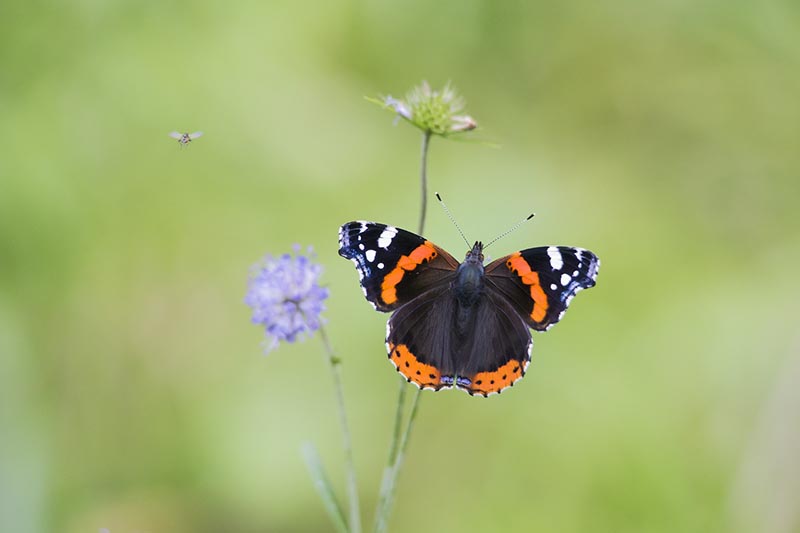
Butterflies are undoubtedly one of the most beautiful creatures on earth. Not just beautiful, but also unique in the sense that they often use their feet to taste various flowers. Do they have tongues? Yes, and they are functional as well.
Some would say that’s unhygienic and disgusting, but that’s the beauty of nature. It made sure that their feet had several tiny sensory organelles, which gives them the ability to quickly get a taste of whatever flower they landed on, before moving on to the next plant.
If you think about it, that’s kind of like tasting a burger without using your tongue, but fingers.
Long story short, that’s the backstory of why we’re excited to talk about the different butterfly species found in Texas. In case you haven’t heard, Texas is one of the states that has an environment that supports the profusion of different species. You’ll always find different types of birds, arachnids, insects, animals, and even freshwater fishes.
So read on if you’d like to learn a thing or two about our rainbow-colored friends.
The 8 Types of Butterflies in Texas
1. Monarch Butterfly
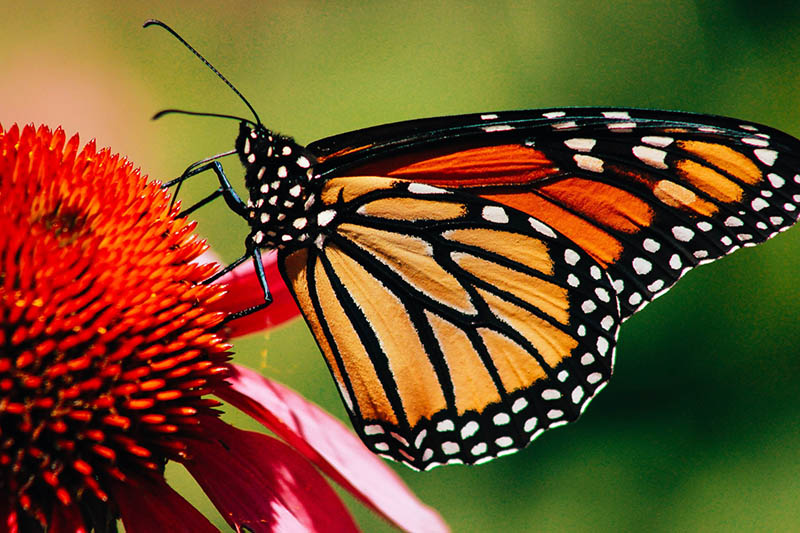
| Wingspan: | 3.5–4 in |
| Conservation Status: | Endangered |
Scientifically known as the Danaus plexippus, the Monarch is the most common, loved, and recognizable butterfly species on the planet.
As kids, we always drew butterflies with orange and black wings. We used to think that those were the typical colors of all butterflies, but they are not. You see, without our knowledge, we were giving our butterfly drawings the conventional colors of the Monarch.
In addition to possessing those striking colors, they are also huge proponents of migration and lovers of the milkweed plants. Speaking of, this habit of feeding on milkweeds is the reason why most predators tend to steer clear of them. The plant makes them mildly toxic and very bitter.
2. Red Admiral
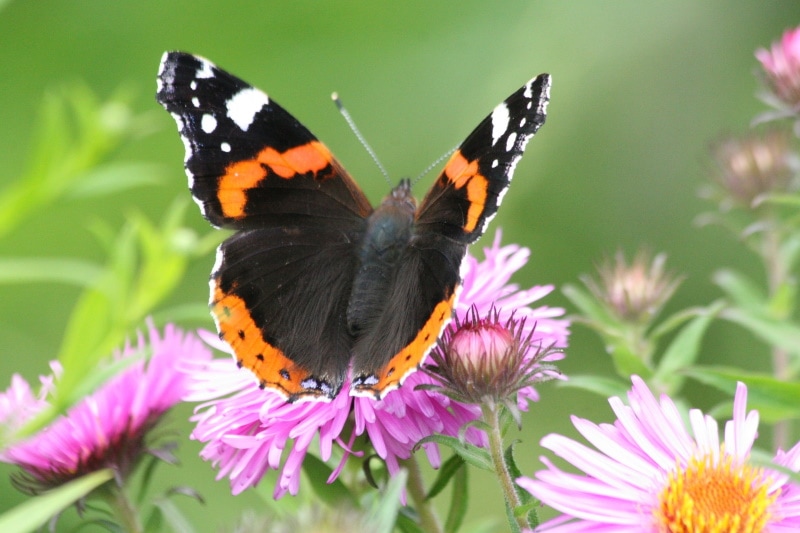
| Wingspan: | 1.75–3 in |
| Conservation Status: | Least Concern |
No, the Admiral doesn’t command any fleet, if that’s what you’re thinking. It’s called the “Red Admiral” because of its scalloped black-brown pair of wings—and the forewing’s reddish band—which makes it look like a species that’s wearing an admiral’s uniform.
The Admiral is usually mistaken for the Monarch, Viceroy, or Painted Lady. In fact, if you’re not experienced in the field, you’ll think they are all the same species. Largely due to the fact that the red sometimes appears orange and the patterns on the wings resemble those of the other species.
It’s also important to note that the Red Admiral is part of the Nymphalidae family. A family that consists of the White Admiral and the Weidemeyer’s Admiral. They are both found in North America, but the White Admiral has other relatives in Japan, Eurasia, and Great Britain.
The Red Admirals are migratory in nature, just like the Monarchs. The only difference is, they are considered partial migrants. They’ll densely populate a particular region during the warm season, and leave once the temperatures start dropping. Not all of them, though, as some will remain behind to weather out the storm.
3. Painted Lady
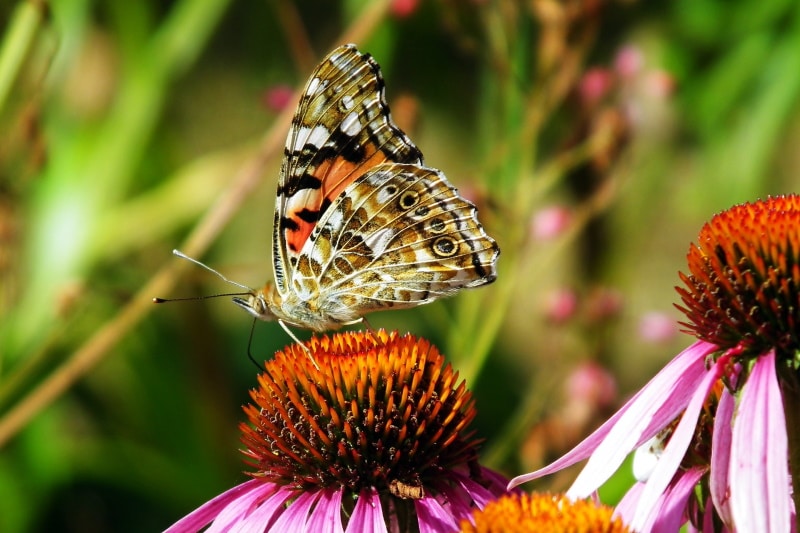
| Wingspan: | 2.25–3 in |
| Conservation Status: | Least Concern |
The Painted Lady is normally mistaken for the Red Admiral or the American Lady. If you ever find yourself confused, just pay close attention to the subtle color differences (in the case of the Red Admiral) or count the total number of eyespots that it has (while trying to distinguish it from its American counterpart).
The shade has to be pinkish-orange—not reddish-orange—and the total number of eyespots is four. The American species only has a total of two.
According to lepidopterists, the Painted Lady is the most common butterfly species in the world. This makes sense, seeing as they are long-distance migrants. You’ll find them evenly distributed all over the state of Texas during summer, and in Mexico during winter.
As adults, they’ll feed on nectar, mainly drawn from asters, clover, and thistles. But while they are in their larval stage, they prefer sticking to legumes and mallows.
4. Viceroy

| Wingspan: | 2.5–3.25 in |
| Conservation Status: | Least concern |
We learned that the Limenitis Archippus likes to mimic the Monarch’s appearance to avoid predation. It’s an evolutionary strategy that they developed when they noticed that most predators only pick on them and not the other species. Needless to say, they are not toxic at all, or naturally aggressive.
But the same can’t be said of the Viceroy caterpillar. They have a way of isolating the salicylic acid found in their bodies, to ensure that any predator that feeds on them suffers from a severe stomach upset that could potentially lead to death.
The predator might not live long enough to tell the tale, but the caterpillar will have saved hundreds of other caterpillars from experiencing the same fate. There are instances where we’ve found them masquerading as bird droppings, to hide from anything lurking in the shadows.
The only way of distinguishing the Viceroy from the Monarch is to look for a black line at the bottom section of their wings. If you don’t see any line, it’s certainly a Monarch species. Viceroys always have that line.
5. American Lady
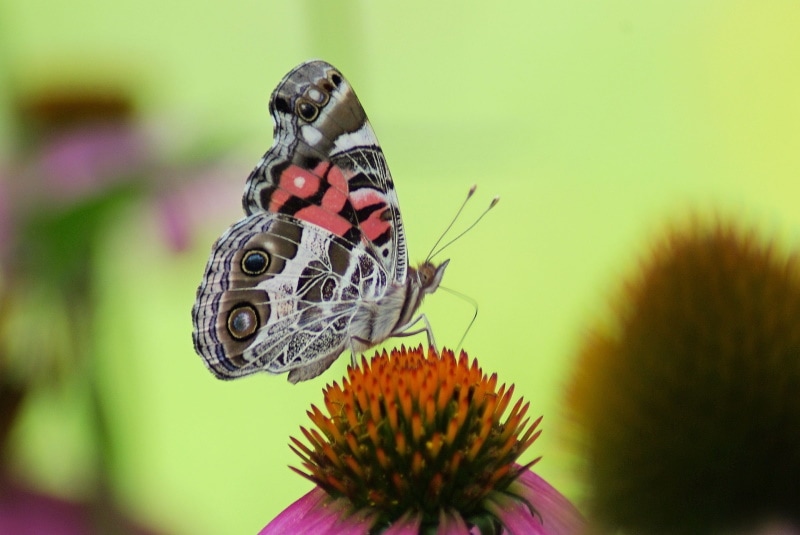
| Wingspan: | 1.75–2.12 in |
| Conservation Status: | Least Concern |
Some people know it as the Hunter’s butterfly, while others prefer calling it the Painted Beauty. Where we come from, it’s called the American Lady, otherwise known as the Vanessa virginiensis.
Even though this species is very attractive, that’s not the attribute that makes it popular among naturalists. They love it for its nest-building skills more than anything else. The nests are usually made at the very top of a host plant, by silking different-sized leaves and chaff together. We don’t know how they manage to make it hold, seeing as it’s always located at the tip of the flower’s stalk.
Spotting its caterpillar during the day is almost impossible. They’ll be hiding inside the nest, waiting for predators to go to sleep. The only time they’ll come out is once the sun goes down or on overcast days.
When it’s time to feed, the American Lady will look for the common milkweed, aster, vetch, dogbane, marigold, or any other flowing plant that can provide sufficient nectar. The caterpillars have a different preference, as we’ve often found them feeding on burdock, ironweed, or plantain-leaved pussy toes.
6. Giant Swallowtail
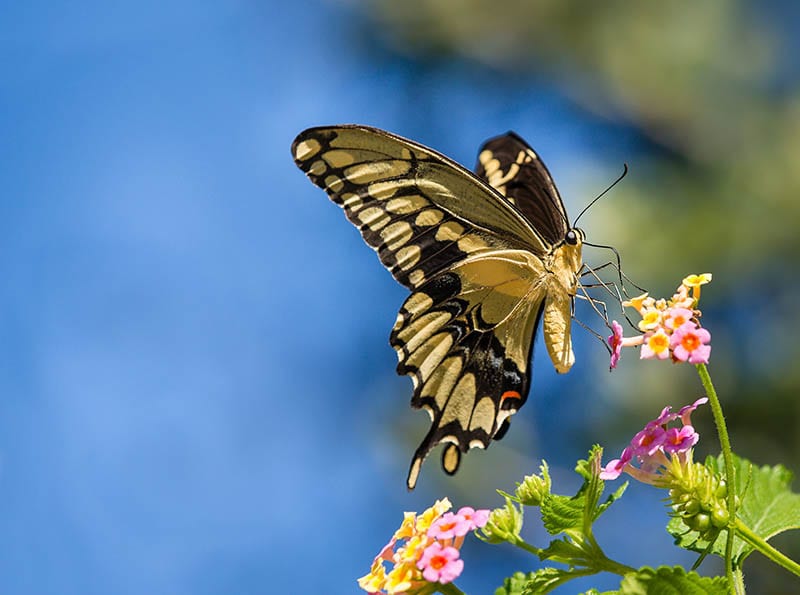
| Wingspan: | 5.5–5.8 in |
| Conservation Status: | Least Concern |
Queen Alexandra’s Birdwing is for sure the largest butterfly in the world—that’s an indisputable fact. But if the conversation is restricted to the North American continent, there are no other butterfly species that are larger than the Giant Swallowtail.
As an adult, the males have a 5.5-inch forewing span on average, while that of the females measures 5.8 inches. The other thing that you’ll note the minute you spot one is the color of its dorsal wing surfaces. They are either black or dark brown, accompanied by a yellow bar across the forewings.
If you’d like to see one, go to East Texas. You can also find a small population in North and Central Texas, especially in the wooded areas. This species also likes feeding on milkweeds, in addition to zinnias and lantana. So, you can try to lure them to your garden by planting any one of those plants.
7. Desert Marble
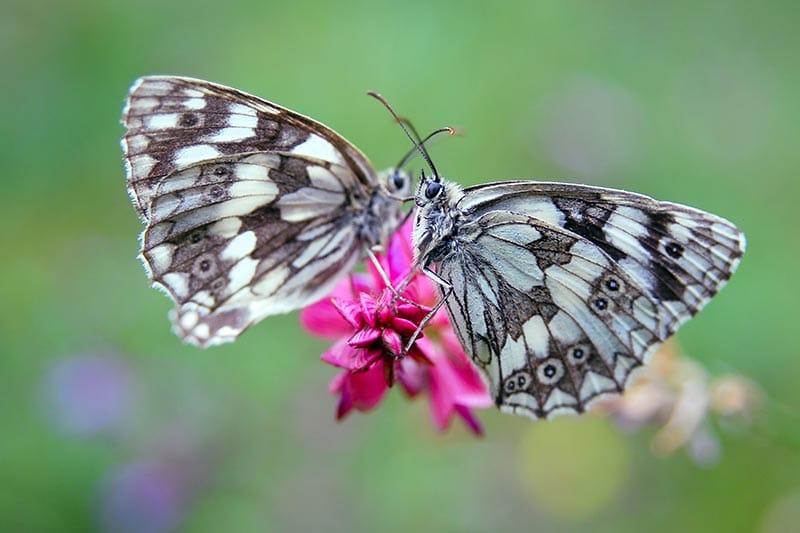
| Wingspan: | 1.25–1.75 in |
| Conservation Status: | Least Concern |
The Euchloe lotta is not as common in the US as it is in Canada. If you’re interested in studying them, you’ll have to visit the Chihuahuan desert or cross the border to British Columbia. A few researchers believe the Desert Marble and the California Marble should be treated as the same species, but that’s still up for debate.
They might have the same physical appearance but genetically, they are sort of different. Could be due to the different climatic conditions or not. Our brilliant scientists are yet to determine that.
Identifying this butterfly shouldn’t be a problem to anyone who remembers its wing’s topside is mostly white with black markings, while the underparts have green marbling. When it’s time to start breeding, it will look for a host plant and lay eggs on the stem, leaves, buds, or flowers.
8. Hackberry Emperor
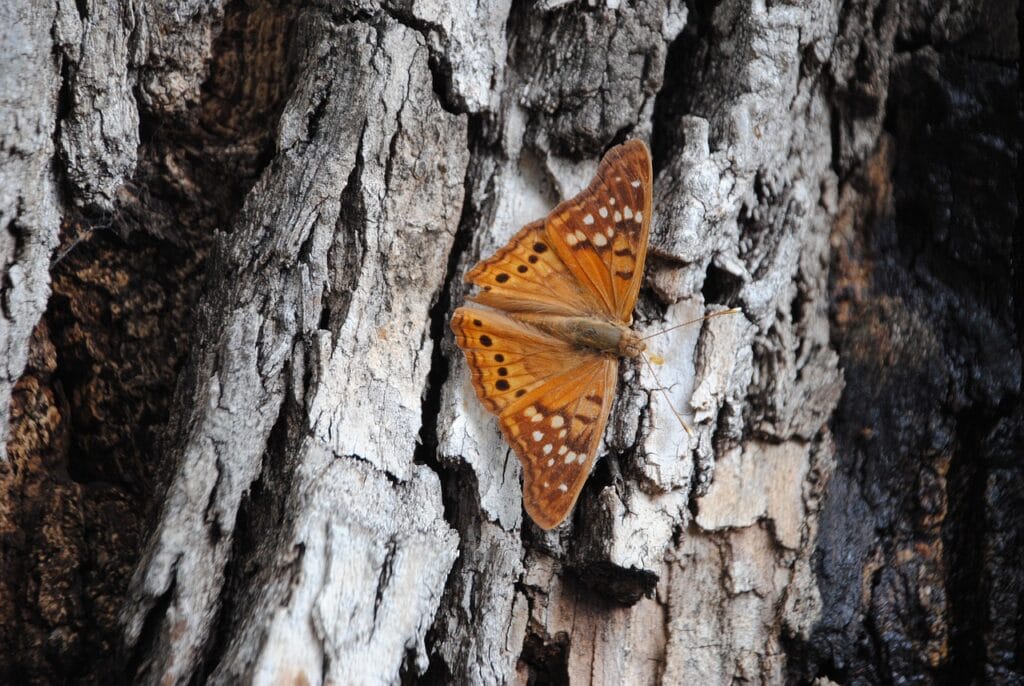
| Wingspan: | 1.5–2.25 in |
| Conservation Status: | Least Concern |
The Asterocampa celtis is a North American native that’s part of the brush-footed butterfly community. Brush-footed butterflies are also four-footed, a term used to describe a family of butterflies that have reduced forelegs. Those legs are unusually hairy and look exactly like brushes.
It was named after its one and only host plant, the hackberry, which also doubles up as the larvae’s primary food source.
From what we’ve heard, this butterfly is naturally mercurial and a parasite. By that we mean, it’s one of those organisms that look undecided half of the time and doesn’t pollinate the flowers it relies on for food.
Anytime it visits a flower, it only uses the proboscis to feel and feed. That means that its feet and antennae usually remain up in the air, not collecting the pollen that’s supposed to be transferred from the male flower to the female.
Its main predator is the stink bug, an insect in the Pentatomidae family that loves preying on the Hackberry’s eggs. Raccoons and bears are also unforgiving, especially when they come across their larvae along the forest floor.
Fun Facts About Butterflies
They Don’t Exist in Antarctica
Antarctica is certainly a beautiful continent. Some would even say magical, courtesy of the ethereal silence and blinding-white landscapes. But did you know there are no butterflies in that part of the world?
Something that shouldn’t be surprising, considering Antarctica doesn’t support the growth of any tree species or flowers. If you put two and two together, you quickly realize that the absence of trees automatically translates to no butterfly food—an essential item for survival.
Butterflies Are Cold Blooded
A cold-blooded creature is any animal that cannot regulate its own body temperature, while that of its immediate environment changes. Human beings are warm-blooded because our bodies’ metabolic functions generate heat that helps keep us warm, even in cold situations. When it comes to the butterfly, it relies on external sources, such as the sun.
If they can’t warm up their bodies to 40ºC, they won’t be able to fly. And if they are stationary, they’ll starve to death. That’s why you’ll find them basking in the sun, with their wings spread wide open.
The Skippers Are the Fastest Butterflies
On average, butterflies fly at speeds of about 12.4 miles per hour. But the Skipper is a different breed, seeing as it can clock speeds of 37 miles per hour. To put that into context, if you’re not a professional athlete, you’ll be able to ride your bicycle at a maximum speed of 14 miles per hour. Maybe clock 30, after a few sessions of training.
Conclusion
Unfortunately, today we’ll be ending this post on a sad note. A few months ago, the Monarch butterfly was designated the “endangered” tag. We’re still trying to figure out if what’s affecting them is the loss of genetic variation or climate change.
As a community, we’re asking you to not harm or kill any butterfly that you come across. Once they are gone, they’ll be gone forever, and there’s no changing that.
- https://www.animalfunfacts.net/animal-records/insects/196-the-biggest-smallest-fastest
- https://www.pbs.org/newshour/show/monarch-butterfly-declared-endangered
- https://www.ncbi.nlm.nih.gov/pmc/articles/PMC6983360/#
- https://www.butterflyidentification.org/butterflies-by-state-listing.php?reach=Texas
- https://www.butterfliesathome.com/butterflies-in-texas.htm
Featured Image Credit: Erik Karits, Pixabay
Contents



